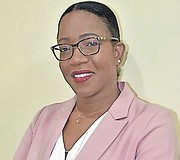By EARYEL BOWLEG
Tribune Staff Reporter
Ebowleg@tribunemedia.net
ACTING Director of Education Dominique McCartney Russell revealed that the public school attendance rate for face-to-face learning is at 95 percent.
She noted there is a problem, however, with students coming consistently everyday for school.
“You may have one or two students who decide Friday is a day off. You know, they want to stay home on a Friday but for the most part, most of our children are coming to school,” the acting director said.
The 95 percent attendance rate was government’s target to meet by December. With the onslaught of the COVID-19 pandemic and implementation of full virtual learning, absenteeism skyrocketed. Students returned to the classroom for face-to-face learning in January.
Mrs McCartney Russell told The Tribune yesterday about the increase in attendance and the work done to get children back into the classroom.
“I can tell you it definitely has increased, simply because principals, especially in the areas where we saw the decline in the attendance, have been using a number of strategies to find the children,” she said.
“The attendance officers have been connecting with principals. They’ve also been calling parents. I know that there has been a great increase, because we actually met with the Prime Minister’s Delivery Unit and those principals indicated that their numbers have drastically increased.”
Education Minister Glenys Hanna Martin had said that some of the COVID police officers who were previously involved in ensuring protocols were complied with have been trained to work with education officials to take on the task of ensuring children are in school.
The acting director of education boasted about the COVID officers’ work in helping with school attendance and the collaborative efforts with schools.
“It’s very advantageous, honestly, because what they do is they have a connection with the school principal and the guidance counsellors and so they’re able to ascertain from the school registers those children who have not attended on certain days,” she said.
“For example, if a child has been missing for three days, you know, that’s a red flag for us and they get that information from the school personnel and then they go, they look for those children. We always try to ask parents, you know, what may be the issues why the child is not attending. (Is it) something that Social Services can provide or the school can provide?
“We look for ways to ensure that whatever the issues are, those issues could be mitigated, so the child could attend and then, of course, we continue to monitor to make sure that the child continues to go to school.”
Meanwhile, she gave an update on the learning loss assessment. Mrs Hanna Martin had noted that officials planned to test students for learning loss to have a better understanding of COVID’s true impact on education in The Bahamas.
Mrs McCartney Russell said: “It’s moving at a steady pace. Right now the deputy director for curriculum has a meeting with the project manager.”
As for when sit-down examinations will take place in public schools, she noted: “I know it will be in January. We wanted to do it in November but, of course, the timeline had to be pushed back. We need to ensure that we have the connectivity of the devices the teachers have been trained; everybody is aware of what’s going on and so that will probably happen in January.”





Commenting has been disabled for this item.